Understanding the Importance of a Welding Jacket
Why Protective Gear Matters in Welding
Welding is one of the most hazardous professions, involving exposure to heat, flames, and potentially harmful materials. The right protective gear is essential to ensure safety on the job site. A welding jacket serves as a critical barrier between the welder and hazards such as intense heat, dangerous sparks, and molten metal. It’s not just about being equipped; it’s about being equipped properly. A welding jacket is designed to provide the necessary protection, comfort, and durability required in different welding scenarios.
Key Features of an Effective Welding Jacket
When selecting a welding jacket, several features should be prioritized to ensure maximum protection and comfort:
- Flame Resistance: The jacket should be made from materials that are flame resistant, which can withstand high temperatures and prevent ignition.
- Durability: Look for materials that are tough and can endure regular wear and tear in demanding environments.
- Comfort: A properly fitting jacket with appropriate ventilation is crucial to maintain comfort during long hours of work.
- Protective Features: Consider jackets with additional protective features such as high collars, adjustable cuffs, and reinforced stitching.
Different Material Types and Their Applications
The material of a welding jacket significantly impacts its suitability for various welding tasks:
Cotton: Often treated with flame-resistant chemicals, cotton jackets are highly breathable and comfortable for hot environments but may not offer as much protection as leather.
Leather: Leather jackets provide superior protection against sparks and heat, making them ideal for heavy-duty welding. They are durable and often more suitable for high-temperature conditions.
Specialty Fabrics: Some jackets incorporate advanced fabrics that combine cotton and synthetic materials to enhance breathability while retaining heat resistance.
Types of Welding Jackets: Finding the Perfect Fit
Cotton vs. Leather: Which is Ideal for You?
The choice between cotton and leather jackets largely depends on your specific welding tasks:
Cotton Jackets: Best for light to medium-duty welding, cotton jackets are breathable and comfortable but may lack the longevity needed for intensive work.
Leather Jackets: Recommended for heavy-duty welding tasks, they offer better protection against heat and splatter as well as a longer lifespan, although they might be pricier.
Flame-Resistant Features to Look For
Understanding the standards for flame resistance is crucial. Look for jackets that meet or exceed the ASTM F1506 standard, as this ensures that they will effectively protect against flame and thermal exposure.
Specialized Jackets for Different Welding Techniques
There are various specialized jackets tailored to the different types of welding processes:
MIG Welding: Requires jackets that are lightweight but flame-resistant, to allow agility.
TIG Welding: Often needs tighter-fitting jackets to prevent the cloth from catching on the welder’s equipment.
Choosing the Right Size and Fit for Maximum Comfort
How to Measure Yourself for the Best Fit
Choosing the right size is essential not only for comfort but also for safety. Measuring your chest, waist, and arm length will help you find a jacket that fits well. Each manufacturer may have a different sizing chart, so always refer to those before purchasing.
Common Fit Issues and Solutions
Problems can arise with fit, from sleeves that are too long to jackets that are too baggy, which can expose your skin to hazards. If you encounter such issues, consider getting adjustments made by a tailor, or look for brands that emphasize a range of sizes and fits.
Adjustability Features to Consider
Look for jackets with adjustable cuffs, hems, and collars that allow you to customize the fit according to your needs. Velcro straps and drawstrings can significantly enhance comfort and functionality.
Maintenance Tips for Your Welding Jacket
Cleaning and Care Best Practices
Proper maintenance of your welding jacket is essential for prolonging its life:
- Read the Care Label: Always follow the manufacturer’s instructions for cleaning to avoid damaging the fabric.
- Regular Washing: Dirt and metal spatter should be cleaned off regularly to maintain the jacket’s protective qualities.
- Spot Cleaning for Leather: Use a damp cloth to clean leather jackets and apply leather conditioner to keep the material supple.
Storing Your Jacket Safely
Store your welding jacket in a cool, dry place away from direct sunlight to prevent fabric degradation. Hanging the jacket can help preserve its shape and avoid wrinkles.
When to Replace Your Old Welding Jacket
Monitor your welding jacket for signs of wear, such as fabric thinning, fraying, or discoloration. If you notice any of these signs, it’s time to consider a replacement to ensure adequate protection.
Where to Buy Quality Welding Jackets
Top Brands to Consider
Several reputable brands specialize in welding apparel that are worth considering:
- Miller Electric: Known for their high-quality welding gear, offering a range of jackets suited for various welding tasks.
- Tillman: Offers a selection of leather and cotton welding jackets with a focus on durability and comfort.
- Revco Black Stallion: Renowned for their flame-resistant products, catering to different styles and preferences.
Online Retailers vs. Local Shops
When shopping for a welding jacket, consider both online retailers and local shops. Online options might offer wider selections and competitive prices, while local shops provide the benefit of trying items on before making a purchase.
Important Considerations When Shopping
Selecting the right welding jacket involves considering factors such as:
- Material: Ensure it meets your protection requirements based on the type of welding you’ll be performing.
- Fit: Prioritize comfort and adjustability to accommodate various working positions.
- Price: Determine a budget. Investing in quality may save money in the long run by providing better durability.
